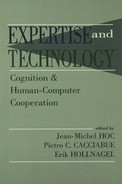SUBJECT INDEX
Accident analysis 63–64
ACT* 48–50
Action monitoring 66–67
Adaptivity 232
Cognitive architecture 43–52
Cognitive Environment Simulation (CES) 76–83
Communication 169, 171–172, 174–180, 216
Competence 13–14, 125–127, 130, 134
Complexity 126–129, 134, 135, 137
Cooperation
between humans 129–130, 136, 167–181
between humans and machines 7–9, 183–185, 187, 191, 213–227, 229–240
degree 217
horizontal 221–225
vertical 220
Coupling 229–240
Decision-making 19–38, 127–129, 133–135, 136
distributed 214–215
Design 229–240
of interfaces 60, 183–184, 191, 230, 232, 236
of procedures 61
Diagnosis 19–38, 82, 147, 149, 152–155, 157, 160
Diagnosis
causal 21
& decision-making 24–26
error 99–105
functional status 21–23
medical 93–105
psychological models 23–26, 31–38
strategies 31–33
as structure induction 23–24
time aspects 29–31
Distributed artificial intelligence 9, 215–220
Distributed cognitive systems 79
Disturbance or fault 76–77, 81, 88, 142–161, 184, 187–188, 191–192
Dynamic system, situation, or environment 4–5, 19–38, 75–90, 108, 125–126, 128, 131, 133, 134, 137, 255–277
Error
detection 204–205
diagnosis 99–105
erroneous action 9–10
identification 205–206
recovery 206
Expert systems 65–66
Function or task allocation 184–185, 189, 192
Functional systems 44
Functionality 125–137
Gulf of execution and gulf of evaluation 6–7, 8
Information processing psychology 43–52
Intelligent decision support system 66
Intention or intentionality 5–7, 169, 174, 176–178, 255–277
Joint cognitive system 1, 9, 11, 55, 75–90
Knowledge
mutual 167–169
representation 26–29, 109, 111, 112, 114–115, 117–121
Mediatization 128–129
Metaknowledge 130–131, 133, 135
Micro- & macro-cognition 57–59
Model (of the system)
conceptual 107–122
mental 107–122
operational 116
Minimal Modelling Manifesto 12
Multi-Flow Modelling 9, 261–272
Monitoring 191
Operator support 230, 232, 236
Organizational setting 126–128, 130
Orientation 141–161
Physical symbol systems 45
Plan recognition 235–236
Prototyping 62
Rationality
bounded or limited 80
Representation
empirical 115
functional 115
chematic 112
structural 114
teleological 115
Resources 34–38, 126, 128, 136, 168–170, 172–174, 178
Risk & reliability analysis 62–63, 240
Self confidence 191–192
Simulation 11–13, 43–52, 55–69, 75–90, 125–126, 133, 135–137, 168, 173–174, 179
degree of specificity 68
level of granularity 68
normative vs. descriptive 67
static vs. dynamic 67
Situation recognition 248–250
Speech act theory 173, 176–177
Strategy 31–33, 125, 131, 133–134
System certification 243–252
Task description 272–276
Thinking (analytical, empirical, intuitive, theoretical) 158–161
Time management 29–31, 82, 88, 127–128, 135, 137
Training 64, 103, 117–122, 125–137
Trust 183–192
Underspecification theory 50–51
Understanding (the system) 2–4
